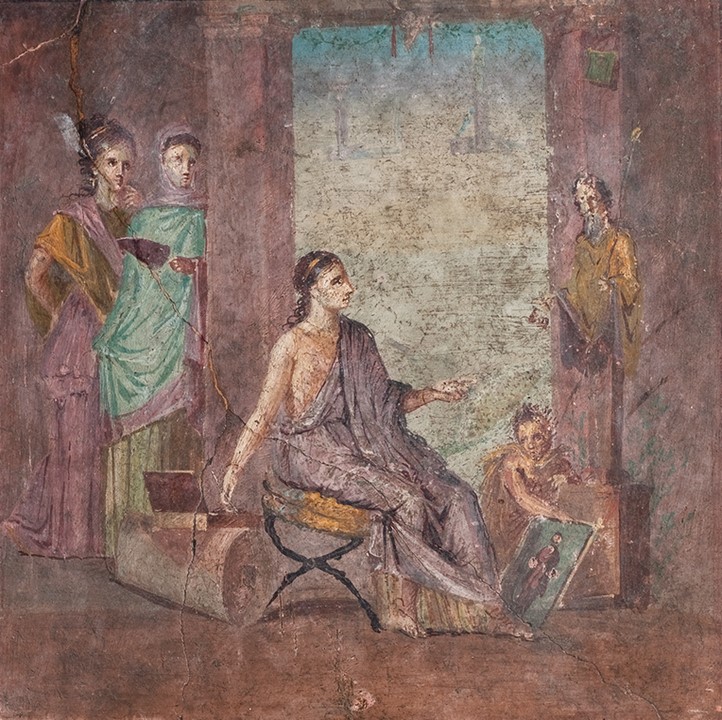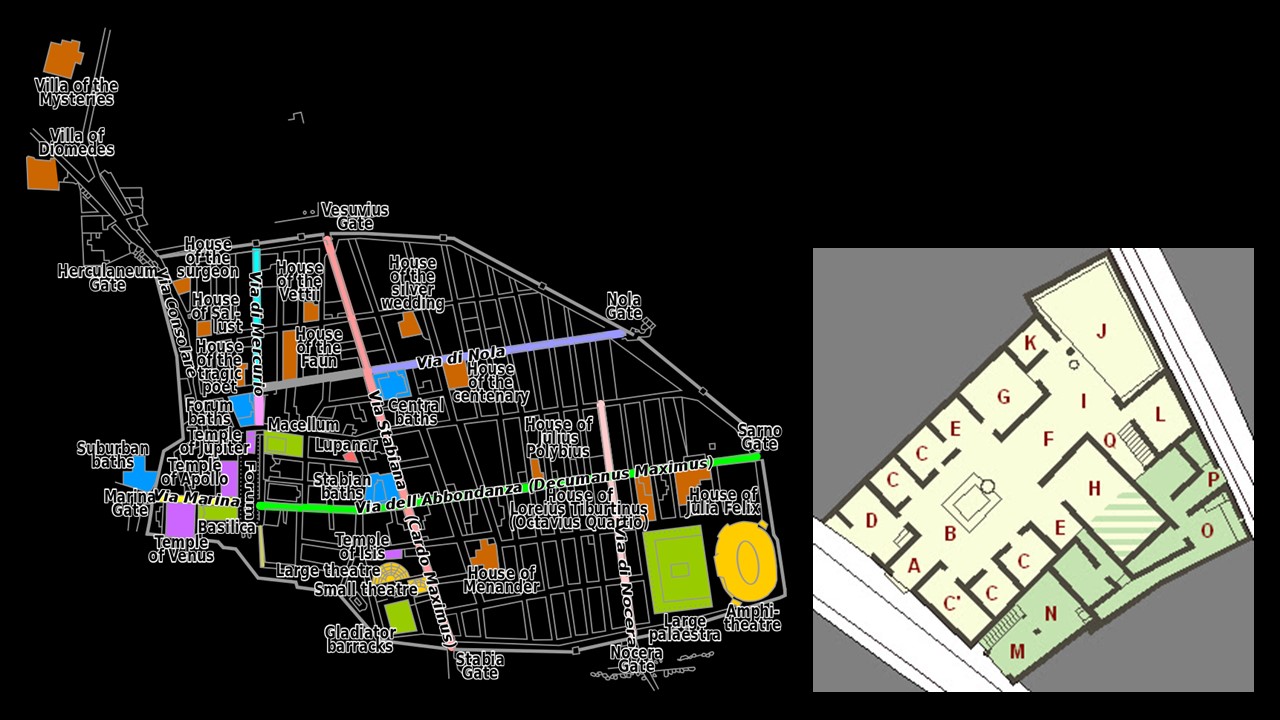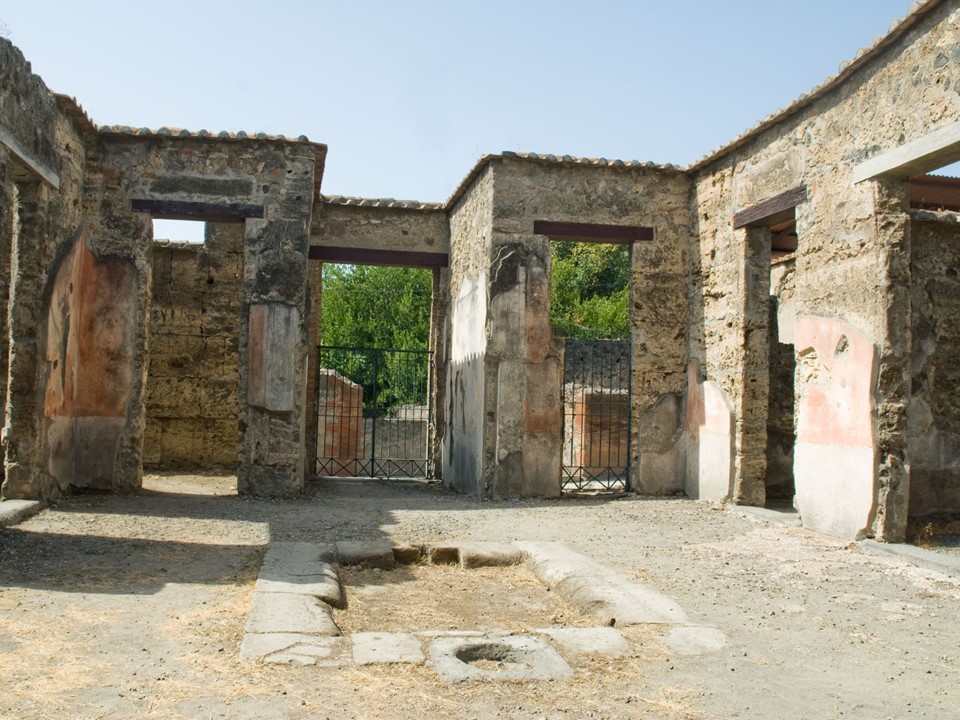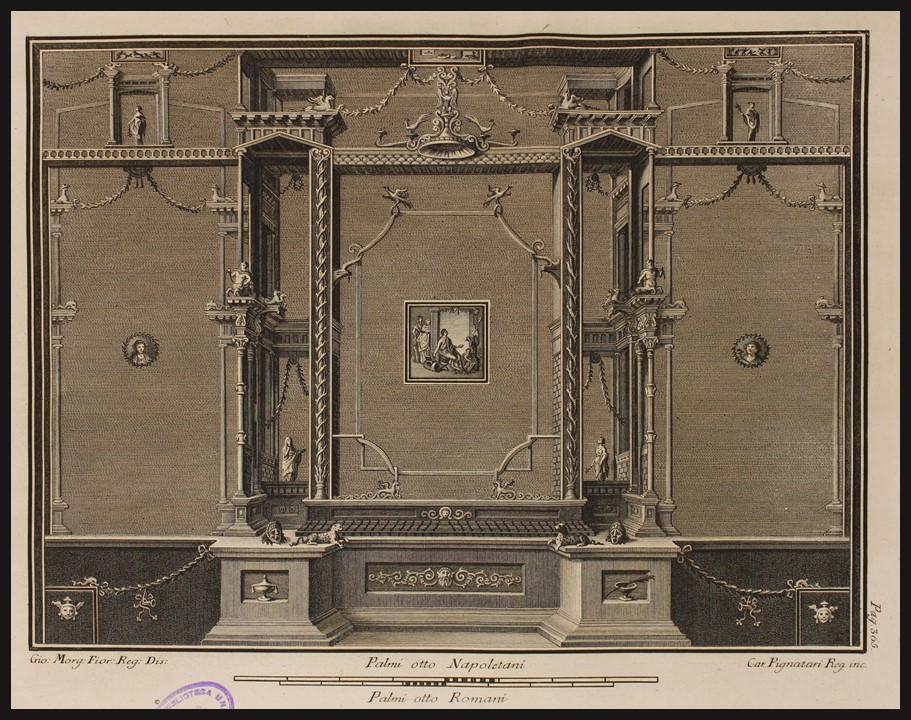
Pompeii in Color: The Life of Roman Painting Exhibition at the New York University Institute for the Study of the Ancient World (through May 29, 2022) presents thirty-five frescoes from the National Archaeological Museum of Naples. Among these important works, all originally from Roman homes is a favorite painting of mine, titled Painter at Work! It comes from the Pompeian House of the Surgeon, and it is a Gem! https://isaw.nyu.edu/exhibitions/pompeii-in-color
The amazing Pompeian fresco of a female painter immersed in her work… observed and admired… “bathed” in “aubergine” tones, attracts our attention, and captivates our eyes. The Questions and Answers that follow, will hopefully help us solve hidden clues, understand the fresco’s importance, and enjoy its charm!
Where was the Fresco titled Painter at Work discovered?
The fresco was found in the House of the Surgeon, in the ancient city of Pompeii, located in the Bay of Naples, or as Cicero would call it, the “the crater of all delights.” Pompeii was the favorite vacation spot of the Roman elite. Roman Emperors and their wives, members of the old aristocracy, and representatives of the new money elite were all, more than enthusiastic to live or vacation on the Neapolitan coast. The name of the House’s owner may not be known, but a toolkit of bronze and iron surgical instruments discovered during excavations is responsible for its modern name. https://www.smithsonianmag.com/arts-culture/roman-splendor-in-pompeii-59083755/

https://en.wikipedia.org/wiki/House_of_the_Surgeon
https://sites.google.com/site/ad79eruption/pompeii/regio-vi/reg-vi-ins-1/house-of-the-surgeon
Specific facts about When and Where the House of the Surgeon was built: The House of the Surgeon or Casa del Chirurgo is one of the oldest Italic Houses in the city. It was excavated back in 1771 by the Spanish military architect and archaeologist Francesco La Vega. It is located on the East side of the ancient city (Regio VI, Insula i, Doorway 10), about 50 meters inside the Herculaneum Gate, and dates from the Samnite period, between the 3rd and the early 2nd century BC. At the time of the eruption of 79 AD, the House had fallen into a poor state and was undergoing considerable repair work. https://intarch.ac.uk/journal/issue23/3/case_study.html and https://interactive.archaeology.org/pompeii/field/11.html

https://www.storieparallele.it/la-casa-del-chirurgo-di-pompei/
Where was the fresco of the female Painter at Work discovered? The House of the Surgeon was, once, lavishly decorated with frescoes of the 4th Pompeian Style. Room L, next to the House’s Hortus (Garden), seems special. This is the Room where the Painter at Work fresco was discovered in 1771. The painting was detached, it was considered a protection procedure at the time, and is now exhibited in the National Archaeological Museum of Naples, as a framed panel.

Le pitture antiche d’Ercolano, Tomo Setimo, Tabola LXXXII, pag. 365, Napoli : nella regia stamperia, 1757, TH-Bibliothek Zürich https://commons.wikimedia.org/wiki/File:Delle_antichit%C3%A0_di_Ercolano,_1757-1779_(T._I-VII)_70388_(23839904461).jpg
Describe the Composition: Painter at Work is a wall decoration of a seated woman absorbed in the art of painting! It was discovered in 1771, during the early excavations, in Room L of the House of the Surgeon, in Pompeii. The painting was, at the time, removed, and now is exhibited in the Archaeological Museum in Naples. We do not know the name of the artist who created it, nor the name of the depicted female painter… they are both anonymous, but they both strike us as talented and unique! The portrayed artist sits comfortably on a stool, dramatically framed by a window opening to the sky. The window is bordered by two pillars/posts and is decorated with garlands and a Bucranium. In a faint distance, we can discern a Herm and a Vase standing on a pillar, both typical Hellenistic landscape motives.
The portrayed artist is about to finish her painting of a sculpture that stands in front of her. Her hand reaches back with her paintbrush to a box of pigments balancing on a cylindrical stand… is it the drum of a column? She is looking at the statue of a bearded man… is he God Dionysus as some scholars have suggested? Immersed in her work she is about to put the final touches on her painting placed on the floor directly beneath its model, held by a wreathed boy… is he Cupid? Behind the left Pillar, two richly dressed women stand, looking interested… are they friends, admirers, or sponsors? We can only guess…
There is so much I admire in this small painting! The noble theme of a painting dedicated to the Art of Painting, and thee, by a female artist… The idea of a painting within a painting, with the extra addition of a second small painting hanging on the right pillar… The amazing color scheme employed by the artist, muted aubergine tones and soft sky blues…the atmospheric perspective… and the fainted Hellenistic landscape. This is a grand painting in small size! http://www.pompeiiincolor.com/theme/the-fantastic-and-the-familiar
For more Questions and Answers, please… Check HERE!